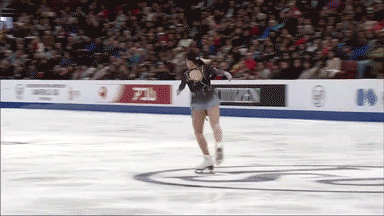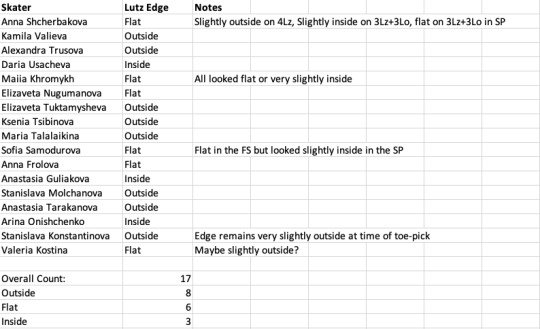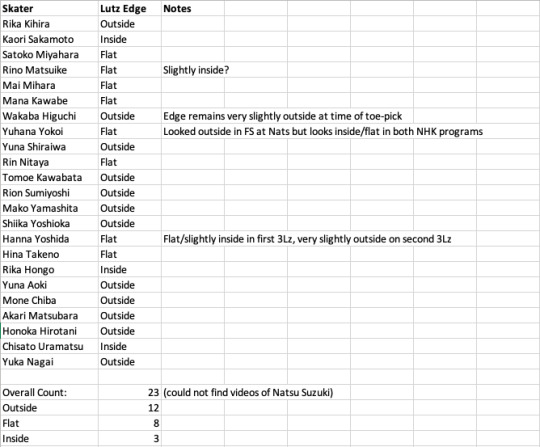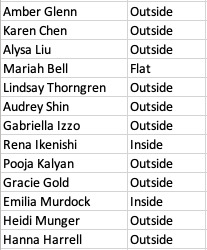#please don't treat this as an invitation to hate on anyone who flutzes
Explore tagged Tumblr posts
Text
Flutzes: How Big an Issue are They?
There is a common belief within skating fans that flutzes (or lutz jumps taken off from a flat or inside edge) are most common among Russian ladies. I have always believed the opposite, but as I am currently taking a statistics course, I thought it would be fun to see how my beliefs, and the common belief, hold up against percentages and proportions. Because I don’t have unlimited time on my hands, I will only be looking into every ladies skater at Russian, Japanese and US Nationals and analyzing their lutz edges (I wanted to do the Korean ladies and I might mention a few just for fun but as Korean Nationals was postponed until next week I’ve decided to leave them out of this for now). Next time I might return with a junior edition (since flutzes seem to be rather common amongst the Russian juniors).

To Begin: What is a Lutz?
The lutz jump is one of the six types of figure skating jumps. The ISU defines the lutz as “a toe-pick assisted jump with an entrance from a back outside edge and landing on the back outside edge of the opposite foot”. Here are two textbook examples of what a lutz should look like:

(The landing here isn’t great - see the ice flying, but the takeoff is just perfection)

Both of these jumps, and any good lutz jump, have deep outside edges. Another qualification one may bring up is prerotation, but this post is mostly just analyzing whether or not certain skaters flutz - not whether or not their lutz is textbook overall. So there are a lot of skaters to be mentioned that have good outside edges on their lutzes, but their lutzes can’t be considered “textbook” because they prerotate far more than the acceptable amount. But that is a whole other controversial topic that really deserves a post of its own.
So what is a bad lutz then?

In this jump, the skater takes off from an inside edge, instead of the outside edge that the other two skaters use. There are some other issues with this particular jump, but the inside edge is the issue which is most glaring.
The Russian Ladies

Here are my conclusions drawn from Russian Nationals. Interestingly enough, besides Konstantinova, every other skater with an outside edge had a very clear outside edge. Out of the ladies with flat edges, some looked more inside (Samodurova’s namely but also Liza Nugumanova’s), while others looked more outside (Kostina’s), but because they all looked flat more than inside/outside, I grouped them together.
The Japanese Ladies

I only looked at the 24 ladies who qualified for the free skate, and for many of them I ended up having to use videos from the National Winter Sports because JSF doesn’t post full videos of their skates at Japanese Nationals to YouTube. I also couldn’t find any videos of Natsu Suzuki, so I could not include her in this analysis.
The American Ladies

Sadly there were a lot of American ladies that I couldn’t find videos of - so this is a rather short list (and probably not very representative).
Analysis:
In the Russian ladies - 47.1% have true lutzes.
In the Japanese ladies - 52.2% have true lutzes.
In the American ladies - 71.4% have true lutzes.
It’s really interesting that so many American ladies have good lutz edges. This is either because I could not find videos of many competitors, or because some competitors who have problematic edges did not jump the lutz (Starr is a good example). However, out of the American ladies, few have “deep” outside edges. Many of them do have “good” outside edges, as in it is very clear that they do, indeed, have outside edges, however few seem to warp the laws of physics like the most textbook examples do. Interestingly, the panel at US Nationals did call out many of the problematic lutzes with lower level skaters, while blatantly ignoring Bradie and Mariah’s clear flat edges.
Out of the Japanese ladies with outside edges, not that many have “deep” outside edges either. I would say Rika, Tomoe and Honoka have really great deep edges. A few of the ladies I wrote as outside really have iffy edges (Wakaba’s probably the best example - sometimes its outside, sometimes it looks more flat).
Out of the Russian ladies with outside edges, many have good outside edges. Except for Stanislava, all the ladies with outside edges have very clear outside edges (unlike in the other two countries oddly). I used to assume that coaches played a big part in whether or not a skater had an outside edge, but it appears this data says otherwise. The most interesting thing is that the slow motion replays almost always caught the lutzes in the best angle (the same angle as Boyang’s 4Lz in the first gif), and yet, very few lutzes were called.
For example, for the Tutberidze Girls, three have unclear edges and 1 has a good outside edge, however, Sasha Trusova used to be an Eteri girl as well, and also has an outside edge. Same goes for Mishin, who was often mistakingly thought to teach good technique based off of Liza Tuktamysheva’s textbook lutz. But as Samodurova and Guliakova are also Mishin’s student, it appears that this technique does not come from his camp. These conclusions make rational sense as Mishin and Eteri usually do not coach skaters since youth, but rather often take in already established skaters. Eteri has been known to only accept students with their triples. If we were to look into some younger juniors, or some retired (switched disciplines) skaters I think I could present one coach who has consistently presented ladies with correct edges - Panova. Besides Frolova who has a problematic lutz edges, many of her other skaters - Tsibinova, Tarakanova, Sotskova, Sinitsyna, Kanysheva, Kostyuk etc - have had correct flip and lutz edges. This would require some more analysis though.
While it looks like the US ladies clearly have a lead in this category, due to certain circumstances, it is unreasonable to say that overall, American ladies are less prone to flutzing just based off this data. I would do a 1-Prop Z Test but these statistics really do not check any of the assumptions or conditions necessary for such a computation.
Overall, it is really interesting that around 50% of the skaters at Russian Nationals and Japanese Nationals have problematic lutzes. It’s that widespread an issue. No, it’s not just Evgenia Medvedeva or Mao Asada or Anna Shcherbakova that suffer from it. Yes, they aren’t (well, Zhenya and Anya aren’t at least) being punished for it, but neither are a good percentage of the others who have problematic lutzes.
For reference, at Japanese Nationals, only two lutz calls were given in the SP (! for Yoshida and Uramatsu). The tech panel was much harsher in the FS with flip and lutz calls galore (Kaori got “e”, Rika Hongo got “e” and Uramtaus got “e”).
At Russian Nationals, in the SP only three edge calls were given - Trusova’s 3F, Guliakova’s 3Lz and Onishchenko’s 3Lz (which got “e”). In the FS, six edge calls were given (two on flips, two !’s for Guliakova’s 3Lz and one ! and one “e” for Onishchenko’s 3Lz). It is true that out of the lutzes at the competition, Onishchenko’s were the most problematic. However, Daria Usacheva’s were also taken off from an inside edge, and she not only was not called for the three lutzes attempted, but was given high positive GOE for many.
At US Nationals, Ikenishi and Murdock both received “e” calls on their lutzes. Ikenishi receiving one the free skate and Mudock receiving two - one in the SP and one FS. There were no other lutz calls for the event.
Of course, after watching so many events, assuming that flat edges will get ! calls and inside edges will get “e” calls is dreaming of the impossible. At best, really severe flutzes done by lower level skaters may be called, inside edges will be called “!” and flat edges will often be let go with no call nor deduction whatsoever. And while I looked at National protocols, it is true that these results are paralleled in international protocols as well.
So, in conclusion - Russian ladies do not flutz any more than Japanese ladies do. And flutzes are becoming quite a severe problem. Several of the skaters at the top have problematic lutz edges, and it seems like this issue will persist given how the rising generation seems to be struggling with lutz edges as well.
Many use these uncalled Russian flutzes as evidence of Russian overscoring, but in response to those comments I guide you to the PCS section of scoring. That is where the atrocities happen. Most of the top skaters won’t be punished for flutzing, however Russians are gifted extra PCS for existing, while the Japanese, with their excellent skating skills and attention to detail, seem to be getting punished with lower PCS (especially those prone to inconsistency).
#figure skating#figure skating analysis#evgenia medvedeva#Anna shcherbakova#rika kihira#Alexandra trusova#Kamila valieva#Kaori sakamoto#russian nationals 2021#Japanese nationals 2020#Japanese nationals 2021#please don't treat this as an invitation to hate on anyone who flutzes#they are all amazing skaters and ISU is incompetent#or rather RusFed and JSF and USFSA are incompetent#actually USFSA looks pretty competent here but still#us nationals 2021
70 notes
·
View notes